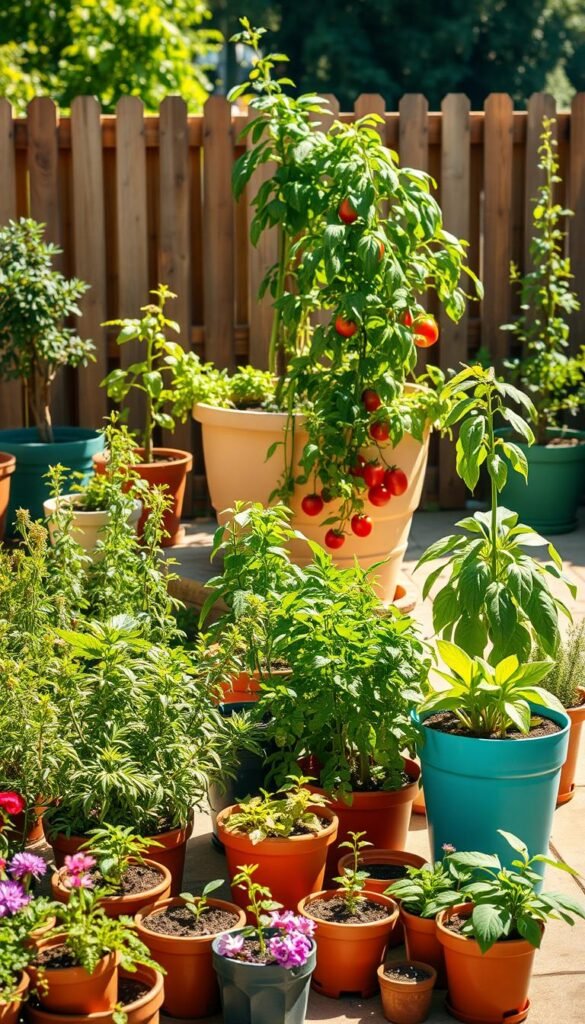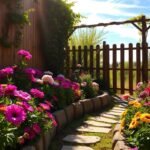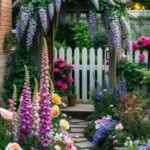Ever dreamed of growing your own plants but feel limited by space or experience? You’re not alone. Small-scale growing is a flexible, budget-friendly way to turn patios, balconies, or even windowsills into vibrant green spaces. This guide simplifies the process, breaking it into easy-to-follow steps so you can enjoy fresh herbs, flowers, or veggies without needing a backyard.
Whether you’re working with a sunny corner or a shaded nook, you’ll learn how to pick the right pots, choose soil that helps plants thrive, and balance sunlight and water. Experts from sources like The Spruce emphasize that success starts with planning—knowing your space, budget, and goals makes all the difference.
Why start with pots? They’re affordable, adaptable, and let you experiment creatively. Imagine growing basil for homemade pesto or bright marigolds to attract pollinators. Plus, troubleshooting issues like overwatering becomes easier when plants are contained. We’ll share pro tips to avoid common pitfalls and keep your greenery happy.
By the end of this guide, you’ll feel confident tackling your first project. No jargon, no overwhelm—just clear, actionable advice tailored to new growers. Let’s dig in!
Key Takeaways
- Ideal for small spaces like patios, balconies, or windowsills.
- Simplifies plant care with controlled soil and watering.
- Affordable setup with room for creativity and experimentation.
- Includes expert-backed strategies for avoiding common mistakes.
- Step-by-step guidance on planning, budgeting, and maintenance.
Introduction to Container Gardening
No backyard? No problem. Growing fresh food and flowers in pots unlocks possibilities for any urban dweller. This method lets you cultivate plants wherever you find sunlight—whether that’s a fire escape, rooftop, or kitchen counter.

What Is Container Gardening?
It’s simply growing edible or decorative plants in portable vessels instead of traditional beds. You might nurture cherry tomatoes in a fabric pot or arrange succulents in repurposed mason jars. According to Better Homes & Gardens, even a 12-inch pot can yield enough basil for weekly pasta nights.
Benefits of Gardening in Small Spaces
Controlling soil quality becomes effortless since you’re not battling existing ground conditions. Want more drainage? Mix perlite into your potting blend. Need moisture retention? Add coconut coir. You’ll also save water by targeting roots directly—no wasted sprinkler runoff.
Rotate containers to chase sunlight through the day. A wheeled planter lets shade-loving ferns avoid afternoon glare while sun-hungry peppers soak up rays. This flexibility helps urban growers work with microclimates.
Start with compact varieties like dwarf kale or patio strawberries. Herbs like thyme and oregano thrive in tight quarters too. With smart ideas, even a 2’x2’ balcony becomes a productive garden.
Choosing the Right Containers
Your plant’s home matters more than you think! The materials and dimensions of your pots shape how roots develop and retain moisture. Let’s break down what works best for your green companions.
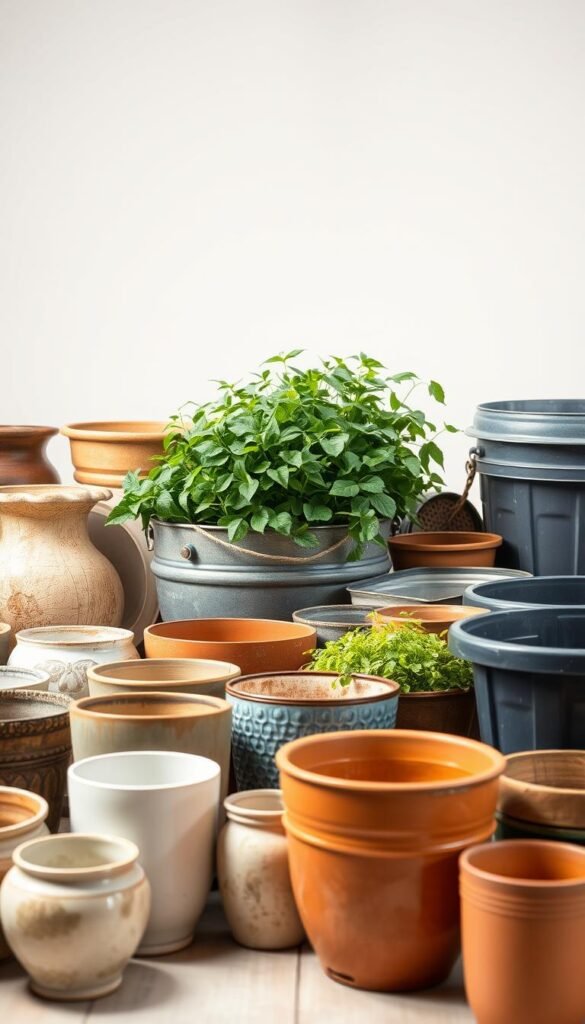
Exploring Materials: Terra Cotta, Ceramic, Plastic, Wood, and Cement
Terra cotta pots let roots breathe with their porous walls—ideal for herbs like rosemary that hate soggy soil. But they dry out quickly in hot climates. Ceramic options add stylish flair but can crack in freezing temperatures.
Plastic containers win for lightweight portability and affordability. A gardening blogger shared how she repurposed old colanders into strawberry planters: “Drill extra holes, and you’ve got instant drainage!” Wooden boxes offer rustic charm but need lining to prevent rot. Cement planters? Perfect for permanent displays but heavy to move.
Understanding Container Sizes for Different Plants
Too small, and roots get cramped. Too big, and soil stays damp too long. Leafy greens like spinach thrive in 6-inch-deep pots, while tomatoes demand 18-inch depths. One urban grower found success with 10-gallon fabric bags for zucchini: “They spread roots without waterlogging.”
Match your container to your plant’s mature size. Shallow-rooted flowers do well in window boxes, while fruit trees need half-barrel planters. Pro tip: Group same-sized pots to simplify watering routines.
Selecting Optimal Soil and Fertilizer
Think of your plant’s soil as its kitchen—without quality ingredients, growth stalls. Unlike backyard beds, potted plants rely entirely on what you provide. Let’s build a nutrient-rich foundation.
The Importance of Organic Potting Soil
Bagged dirt from the discount aisle? Skip it. Organic mixes feed roots with compost, peat moss, and perlite. These ingredients hold moisture without suffocating delicate root systems. A study by Rodale Institute found organic blends increase yields by 30% compared to synthetic options.
Why does it matter? Garden soil compacts in pots, starving plants of oxygen. Specially formulated potting blends stay fluffy, letting roots breathe and absorb nutrients. As one urban farmer puts it: “Your tomatoes can’t order takeout—give them a five-star meal from the start.”
Choosing and Applying the Right Fertilizer
Even the best soil needs a boost. Mix slow-release organic pellets into your container mix during planting. They’ll feed plants for months. Every 2-3 weeks, add liquid seaweed or fish emulsion for quick nutrient hits.
Check fertilizer labels for NPK ratios—nitrogen (N) for leaves, phosphorus (P) for blooms, potassium (K) for overall health. Herbs thrive with balanced 5-5-5 blends, while flowering plants prefer higher phosphorus. Overdo it, and salts build up, burning roots. A pro tip: water thoroughly before feeding to prevent shock.
Visit local nurseries for region-specific mixes. Many offer recycled potting blends that reduce waste. With smart soil and fertilizer choices, your container gardening efforts will flourish!
Container Gardening for Beginners: A Step-by-Step Starter Guide
Ready to transform your space but unsure where to begin? Start by mapping out your vision. A container garden wish list helps you focus on essentials while keeping costs manageable. Think of it as your green-thumb shopping blueprint.
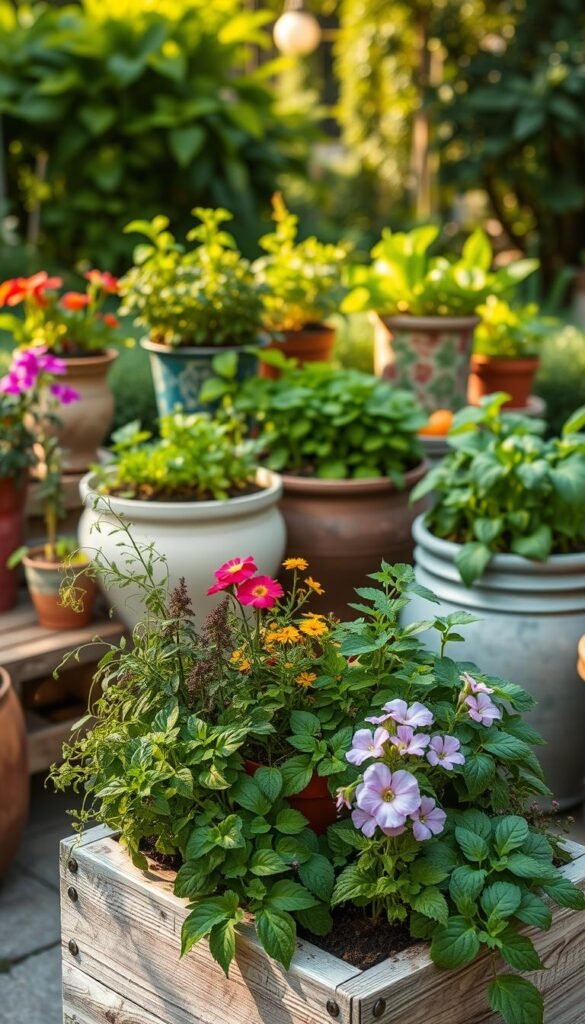
Creating Your Container Garden Wish List
Jot down plants you love and pots that suit their needs. Divide your list into categories: herbs, flowers, or veggies. For example, basil thrives in 8-inch pots, while dwarf tomatoes need 5-gallon containers. This prevents buying mismatched items at the store.
| Plant Type | Ideal Container Size | Budget-Friendly Option |
|---|---|---|
| Herbs | 6-10″ diameter | Recycled tin cans |
| Leafy Greens | 12″ depth | Plastic storage bins |
| Flowering Plants | 14-18″ width | Secondhand ceramic pots |
Budget-Friendly Tips for First-Time Gardeners
Hit up local thrift shops or online marketplaces for unique container ideas. An old colander becomes a strawberry planter, and chipped mugs make perfect succulent homes. One gardener’s advice: “Check restaurant supply stores for durable, low-cost pots.”
Prioritize essentials like soil and seeds before decorative items. Track prices at stores—nurseries often run spring sales. With a clear list, you’ll avoid impulse buys and build a thriving container garden without overspending.
Planting Techniques and Spacing Guidelines
Unlock your green thumb potential by mastering two critical skills: planting methods and smart spacing. Whether starting from seeds or nurturing young sprouts, your approach determines how plants adapt to their new home.
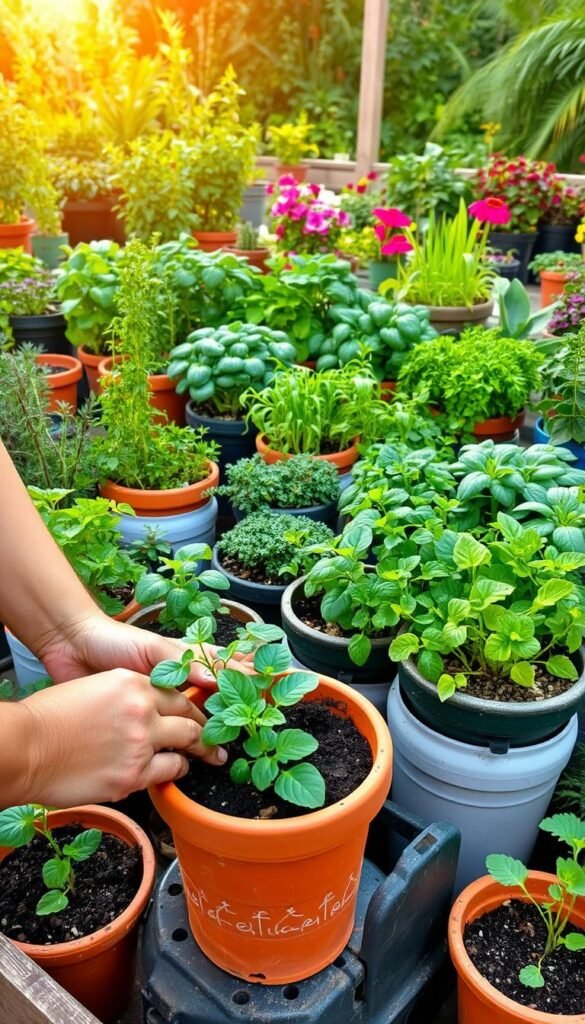
Direct Sowing Versus Transplanting
Direct sowing means placing seeds straight into your pot. It works best for fast-growing crops like radishes or basil. Pros: Less root disturbance. Cons: Slower results in cool weather.
Transplanting lets you jumpstart growth with nursery-bought seedlings. Perfect for tomatoes or peppers needing warm soil. One gardener notes: “I transplant kale 3 weeks before last frost—it outpaces pests!”
| Method | Best For | Key Tip |
|---|---|---|
| Direct Sowing | Root-sensitive herbs, cool-season greens | Plant 2-3 seeds per hole |
| Transplanting | Heat-loving veggies, slow starters | Water seedlings 1 hour before moving |
Proper Spacing to Promote Healthy Growth
Crowded plants compete for light and nutrients. Leave enough room for air to circulate—this reduces mold risks. Measure spacing using your hand: most leafy greens need 4-6 inches between stems.
Check seed packets for mature sizes. Dwarf varieties often thrive in tighter quarters. Rotate pots every few days to ensure even sun exposure. Daily attention helps spot overcrowding early.
- Use chopsticks to mark seedling positions
- Trim excess sprouts instead of pulling them
- Add trellises for vertical growth in small pots
Adjust techniques by season. Summer planting? Water more frequently after sowing. Cooler months? Use heat mats to boost germination. With these tips, your plants will establish strong roots and reward you with abundant harvests.
Watering Strategies for Healthy Containers
Are your plants looking thirsty or waterlogged? Getting moisture levels right is the secret sauce for thriving potted greens. Unlike garden beds, pots dry out faster but also trap excess water if drainage falters. Let’s crack the code for quenching your plants’ thirst without drowning them.
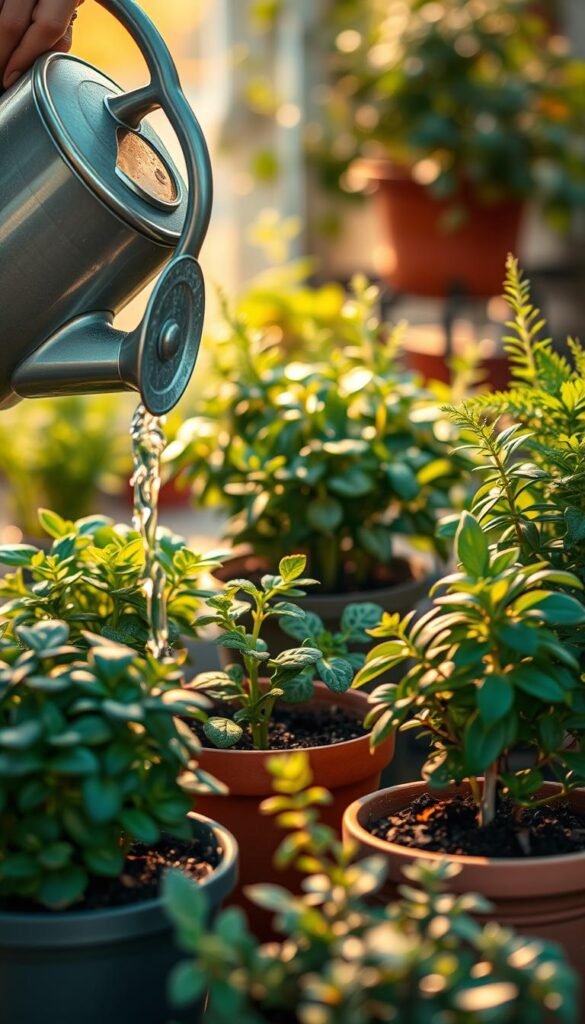
Assessing Soil Moisture and Drainage Needs
Forget guesswork—your finger is the best tool. Push it 2 inches into the soil. If it feels cool and damp, hold off. Dry and crumbly? Time to hydrate. Experts at Proven Winners recommend checking daily in summer since small pots can bake in a single afternoon.
Drainage holes are non-negotiable. Test them by watering until liquid flows out the bottom. If it pools on the surface, poke holes with a screwdriver or switch pots. Add a layer of gravel under soil for extra insurance against soggy roots.
Preventing Overwatering and Root Drowning
Yellow leaves and musty smells scream “too much love!” Let soil dry slightly between drinks to encourage strong roots. Self-watering pots with reservoirs help busy growers maintain steady moisture without daily checks.
| Symptom | Soil Condition | Quick Fix |
|---|---|---|
| Wilting | Bone-dry | Soak pot in a tub for 20 minutes |
| Mold on surface | Soggy | Scrape off mold, add perlite |
| Slow growth | Uneven moisture | Install drip irrigation |
Hot tip: Water early morning to reduce evaporation. During heatwaves, group pots in shaded areas to slow drying. Track your routine—plants drink more when blooming or fruiting. With these tweaks, you’ll master the hydration balance in no time!
Managing Sunlight, Temperature, and Microclimates
Sunlight is your garden’s best friend—until it becomes a frenemy. Understanding how light and heat interact with your space ensures plants thrive instead of barely surviving. Start by tracking patterns: does your patio get morning rays or afternoon blaze? A simple phone app like Sun Seeker helps map exposure throughout the day.
Evaluating Sun Exposure and Shading Options
South-facing areas bake in summer heat, while north spots stay cooler. Concrete surfaces reflect warmth, creating microclimates that trick plants into thinking they’re in a different season. One grower noticed her basil thrived near a white wall: “It bounced back after wilting in open sun.”
Use shade cloth or tall plants like sunflowers to filter intense midday light. Rotate pots weekly to prevent lopsided growth. In peak summer, move delicate greens under a pergola or umbrella during the hottest time (usually 11 AM–3 PM).
Adjust placements as days shorten. A spot that’s perfect for tomatoes in June might leave them shivering by October. Group heat-loving peppers near brick walls that radiate warmth at night. Cool-weather flowers like pansies? Tuck them into shaded corners once autumn arrives.
Watch how structures create sheltered pockets. A balcony overhang might shield from rain but block light. Test different zones—sometimes moving a pot just 12 inches makes all the difference!
Creative Container Ideas and DIY Projects
What if your garden could tell a story? Repurposing everyday items adds personality while saving money. A Brooklyn gardener turned vintage boots into quirky herb planters: “They’re conversation starters and perfect for small spaces.”
Upcycling Everyday Items into Unique Planters
Old dresser drawers become mobile lettuce beds—add casters for easy repositioning. Metal colanders work as strawberry planters, while hollowed-out books create whimsical succulent displays. One thrifter transformed a broken ladder into a vertical herb tower using hanging pots on each rung.
Designing Containers to Suit Your Space
Stack wooden crates to make tiered plant stations for patios. Paint boxes in bold colors to complement your decor. For narrow balconies, mount wall pockets made from recycled gutter sections. A Seattle renter used floating shelves with magnetic pots to maximize her 4-foot-wide space.
DIY Raised Container Gardens for Added Impact
Build elevated beds using pallets lined with landscape fabric. Fill them with cascading flowers and compact veggies for visual depth. One DIYer created a rolling planter cart from an old toolbox: “I grow mint and chives on my kitchen counter—fresh flavors within arm’s reach!”
| Project | Materials Needed | Skill Level |
|---|---|---|
| Teacup Herb Garden | Thrifted cups, drill | Beginner |
| Pallet Vertical Garden | Wood pallet, staple gun | Intermediate |
| Wagon Planter | Child’s wagon, sealant | Advanced |
Mix textures and heights for drama—pair sleek metal troughs with woven baskets. Your container choices reflect your style while solving spatial challenges. Ready to rethink what a planter can be?
Common Pitfalls and Expert Tips
Even seasoned growers face challenges when balancing plant needs with limited space. Recognizing common mistakes early helps your green friends thrive. Let’s explore how to dodge overcrowding and nurture strong roots.
Avoiding Overcrowding and Container Overload
Too many plants in one pot? They’ll fight for resources. A tomato grower learned this the hard way: “I squeezed four seedlings into a 12-inch pot. None produced fruit!” Use this rule: leave space equal to the plant’s mature width between stems.
| Mistake | Result | Expert Solution |
|---|---|---|
| Small pots for large plants | Stunted roots | Upgrade to pots 2x plant size |
| Ignoring drainage | Rotting roots | Add perlite or gravel layer |
| Mixing sun/shade plants | Uneven growth | Group by light needs |
Pro tip: Trim excess leaves weekly to improve airflow. One gardener shares: “I use kitchen scissors to thin basil—it doubles harvests!”
Choose deep pots for veggies like carrots. Shallow containers restrict taproots. For herbs, wider pots let them spread without tangling. Rotate plants monthly to prevent leaning.
Remember: healthy roots mean happy plants. Test soil density by poking a pencil—if it resists, mix in compost. Your greens will thank you with lush growth!
Planning and Organizing Your Garden Layout
Designing your potted paradise starts with smart spatial strategy. Sketch your available space on grid paper, noting sunlight patterns and walkways. Boston-based gardener Lila Martinez shares: “I use painter’s tape to outline pot positions before filling them—it prevents reshuffling later.”
Mapping Out Container Placement and Movement
Group plants with similar needs together. Mediterranean herbs like rosemary thrive in sunny, dry corners, while ferns cluster well in shaded nooks. Create a list matching each plant to its ideal spot—windowsills for compact greens, patios for flowering displays.
Consider these ways to balance function and beauty:
| Plant Type | Container Size | Placement Tip |
|---|---|---|
| Leafy Greens | 12″ wide | Near water sources for easy hydration |
| Flowering Annuals | 14-18″ deep | Entryways for visual impact |
| Trailing Vines | Hanging baskets | Above seating areas |
Add decorative content like painted rocks or miniature statues between pots. One urban grower placed mirror panels behind her containers to amplify light—her mint yield doubled!
Rotate mobile planters weekly for even sun exposure. Use rolling carts or lightweight resin pots for flexibility. With a clear plan, you’ll spend less time hauling water and more time enjoying your green oasis.
Conclusion
Transforming small spaces into lush gardens is simpler than you think! By focusing on quality soil, the right-sized pot, and consistent water routines, you’ll create thriving ecosystems. Whether growing crisp vegetables like cherry tomatoes or fragrant herbs, success starts with understanding your plants’ needs.
Every season offers lessons. Summer heat demands daily checks for thirsty roots, while cooler months let you experiment with cold-hardy greens. Learn from others’ experiences—swap tips with local growers or online communities to avoid common pitfalls.
Your journey grows richer with each harvest. A well-planned container garden rewards patience and attention, yielding fresh food and vibrant blooms. Start small, celebrate progress, and adapt as you discover what works in your unique space.
Ready to dig deeper? Grab a box of seeds, choose a sunny corner, and let nature handle the rest. With every day of care, you’re cultivating more than plants—you’re nurturing confidence and joy in your green-thumb adventures!

